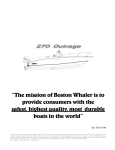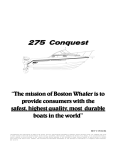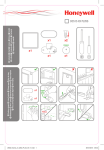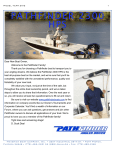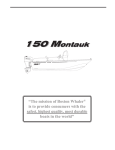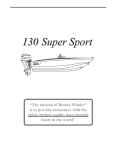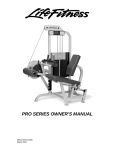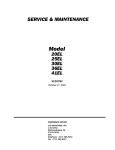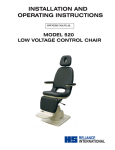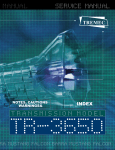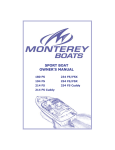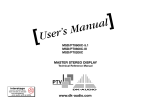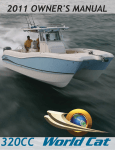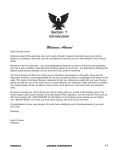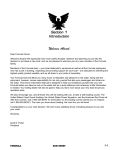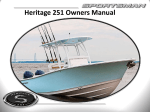Download 240 OR rev E.p65
Transcript
“The mission of Boston Whaler is to provide consumers with the safest, highest quality, most durable boats in the world” ® Rev E 10/11/05 INFORMATION IN THIS PUBLICATION IS BASED ON THE LATEST PRODUCT SPECIFICATIONS AVAILABLE AT PRINTING, BOSTON WHALER® BOATS, INC. RESERVES THE RIGHT TO MAKE CHANGES AT ANY TIME WITHOUT NOTICE, IN THE COLORS, EQUIPMENT, SPECIFICATIONS, MATERIALS AND PRICES OF ALL MODELS, OR TO DISCONTINUE MODELS. SHOULD CHANGES OR MODIFICATIONS TO THE MODELS BE MADE BOSTON WHALER® IS NOT OBLIGATED TO MAKE SIMILAR CHANGES OR MODIFICATIONS TO MODELS SOLD PRIOR TO THE DATE OF SUCH CHANGES. THE FOLLOWING ARE REGISTERED TRADEMARKS OF THE BRUNSWICK CORPORATION: 240 OUTRAGE, BOSTON WHALER®. MRP #1808105 History In 1958, company founder Richard T. Fisher introduced the first Boston Whaler boat in Braintree, Massachussetts. It featured two significant innovations: first, its twin sponson hull design produced superior stability and a remarkably dry ride; second, its unique foam core construction made the boat not only durable, but unsinkable as well. Fisher took every opportunity to illustrate the unique characteristics of the Boston Whaler. His most famous demonstration was captured in 1961, by Life Magazine. The series of photographs showed the boat underway, the boat being sawed in half and ultimately Fisher motoring away in the remaining half of the boat. And through the years many other demonstrations have proved the toughness and durability of the Boston Whaler hull. And though you may never cut your boat in half, this only goes to show one thing, people whose livelihood and lives depend on boats consistently choose Boston Whaler because of their seaworthiness, dependablility and the inherent safety of a hull that won’t sink even if severely damaged. Boston Whalers are built to last. For over 40 years Boston Whaler® has strived to make each model better, providing you with a safe and fun boating experience. That is the reason we offer a 10 year limited transferable warranty. It is also an excellent reason why you can trust the safety of your family and friends to a Boston Whaler. PLEASE KEEP THIS BOOK AND OTHER MATERIALS IN A SECURE PLACE, AND BE SURE TO HAND IT OVER TO THE NEW OWNER IF YOU SELL THE BOAT. Boston Whaler founder Richard T. Fisher demonstrating one of the features that has made Boston Whaler the “Unsinkable Legend” in this 1961 LIFE Magazine Photo. Richard T. Fisher was posthumously inducted into the National Marine Manufacturer’s Association (NMMA) Hall of Fame on September 26, 1996 for accomplishments made in marine engineering and construction. 240 Outrage-Owner’s Manual Introduction This Owner’s Manual has been written to provide specific information about your boat and it should be read carefully. Keep this booklet in the Owner’s Manual Packet. The Owner’s Manual Packet has been compiled to help you operate your boat with safety and pleasure. It contains details of the boat, the equipment supplied or fitted, it’s systems and information on it’s operation and maintenance. Please familiarize yourself with the boat and it’s operation before using it. If this is your first boat, or you are changing to a type of boat you are not familiar with, for your own comfort and safety, please ensure that you obtain handling and operating experience before “assuming command” of your boat. Your Boston Whaler® dealer or local Yacht Club will be pleased to advise you of marine safety classes and safe boating classes in your area. ○ ○ ○ ○ ○ ○ ○ ○ ○ ○ ○ ○ ○ ○ ○ ○ ○ ○ ○ ○ ○ ○ ○ ○ ○ ○ ○ ○ ○ ○ ○ ○ ○ ○ ○ ○ ○ ○ ○ ○ ○ ○ ○ ○ ○ ○ ○ ○ ○ ○ ○ ○ ○ ○ ○ ○ ○ ○ ○ ○ ○ ○ ○ Table of Contents Section 1-240 Outrage Introduction Table of Contents Construction Standards Our Hull Servicing your Boston Whaler Hull Identification Number 1 1 2 2 2 2 Section 2-General Arrangement & Specifications 240 Outrage-Specifications & Dimensions Standard Features Notable Options Through-hull Fittings Storage Standard Seating Arrangement Optional Seating Arrangement Label Locations Deck Occupancy 3 4 5-6 7 8 9 9 10 10 Fuel System Diagram Fuel Tank Fuel Fill Fuel Vent Empty Tank Hoses & Fittings Tank Cleaning Primer Bulb Remote Oil System Static Electricity and the Fuel System 11 11 11 11 12 12 12 12 12 13 Battery Information Battery Maintenance Dual Battery Switches Console Wiring Diagram Console Wiring Diagram, Engine Start Main Breaker Panel Wiring Diagram Hull Wiring Diagram Instrument Panel Arrangement, Single Engine Instrument Panel Arrangement, Dual Engine Multi-System Tachometer Multi-System Speedometer Smartcraft® System View Main Breaker Panel Engine Starting Procedure Ignition Shutdown Switch Navigation Lighting 14 14 15 16 16 17 17 18 19 20 20 20 21 22 22 23 Freshwater System Freshwater Pump Freshwater Shower Maintenance Disinfecting the System Freshwater System Diagram Winterizing the System Raw Water Operation/Maintenance Raw Water System Diagram 24 24 24 24 24 24 25 25 25 25 Section 3-Fuel System Section 4-Electrical System Section 5-Water & Waste System Head System Macerator,(optional) Operation/Maintenance Standard Waste System Diagram Optional Waste System Diagram Environmental Considerations 26 26 26 27 27 27 Bilge Pump Operation/Maintenance 28 28 Livewell Operation Standard Livewell Diagram Livewell,(Optional) Operation/Maintenance Optional Livewell System Diagram 29 29 29 30 30 30 Hydraulic Steering Information Operation/Maintenance Filling Power Steering Information Gear Shift & Throttle Control Digital Throttle/Shift,(DTS)® Power Trim Operation Propeller Information Propeller Assembly 31 31 31 32 32 33 33 34 34 Section 6-Bilge System Section 7-Livewell System Section 8-Propulsion System Section 9-Getting to know your Boston Whaler Trim Tabs Operation/Maintenance Mooring Points Lifting Hull Maintenance Hull Maintenance, Blisters Bottom Painting Painted Hull Care, (Bottom) Vinyl Cushion Care Long Term Storage Engine Fuel System Trailer Storage Electrical System Drainage Canvas Care & Maintenance Trailer (Optional) Trailer Safety Bunk Trailer Terminology 35 35 36 36 37 37 37 38 38 38 39 39 39 39 39 39 40 40 40 Section 10-Anchoring Information Anchoring Information Lowering Setting Weighing Anchor Windlass, (Optional) 41 41 41 41 42 Section 11-Maintenance Log & Notes Maintenance Log & Notes Section 1 - 240 Outrage 43 1 240 Outrage-Owner’s Manual Construction Standards “THE MISSION OF BOSTON WHALER IS TO PROVIDE CONSUMERS WITH THE SAFEST, HIGHEST QUALITY, MOST DURABLE BOATS IN THE WORLD”. We are dedicated to creating a superior product providing you with comfort, performance, safety and dependability. All of our boats comply with the safety standards set by the United States Coast Guard and are designed, engineered and manufactured in accordance with applicable recommendations and guidelines of the American Boat and Yacht Council (A.B.Y.C.) and certified by the National Marine Manufacturers Association (N.M.M.A.). Hull Identifcation Number Our Hull 1 2 3 4 No air voids High density closed cell non-absorbent foam High quality resins and gelcoats Woven glass matting 1 2 3 The “Hull Identification Number” is located on the starboard side of the transom wall. This is the most important identifying factor and must be included in all correspondence related to your vessel. Failure to do so will only create delays. Also of vital importance are the engine serial numbers and part numbers when writing about or ordering parts for your engine. 150 150 4 Boston Whaler® hulls are constructed with our patented Unibond™ construction. This involves shooting high density foam into a closed mold system. The foam expands to fill voids in the hull, and when the finished product is pulled from the mold, the deck and the hull are chemically bonded to form a solid, inseparable unit. Servicing your Boston Whaler Hull Identification Number Location Typical H.I.N. Description When your 240 Outrage needs to be serviced or regular maintenance is needed, it should be taken to an authorized Boston Whaler® dealer. To find a Boston Whaler® dealer in your area call: 1-800-942-5379 Domestic/International If a problem is not handled to your satisfaction: Discuss any warranty related problems directly with the service manager of the dealership or your sales person. Give the dealership an opportunity to help the service department resolve the matter for you. 2 Section 1 - 240 Outrage 240 Outrage-Owner’s Manual Note: The Hardtop shown here is for reference purposes only. 9’8” 8’10” 6’8” * 18” ** * 27’7” 23’9” 8’6” Specifications & Dimensions Overall Length 23’9” 7.24 m Trailerable Length 27’7” 8.41 m Bridge Clearance 8’10” 2.69 m Bridge Clearance (no top) 6’8” 2.03 m Beam 8’6” 2.59 m Draft, (Hull Only) 18” .46 m Weight (dry, no engine) 4400 lbs. 1996 kg Swamped Capacity 9680 lbs 4390 kg Maximum Engine Weight 1060 lbs. 481 kg Maximum Weight, (passengers, engine(s), gear,** 3500 lbs 1588 kg Persons 12 Maximum Horsepower 350HP 261 kw Minimum Horsepower 225 HP 167 kw Fuel Capacity 150 gal.(U.S.) 567 L Water Capacity 20 gal.(U.S.) 76 L * Waterline *** Engine Draft,(See Notice) ! NOTICE Specified measurements are approximations and are subject to variance. ! ** NOTICE Exceeding this weight will affect the boat’s performance. DO NOT Exceed the weights listed on the capacity plate. ! *** NOTICE Optional equipment and loading of the boat will affect the draft measurements. Follow the recommendations listed on your capacity plate regarding the maximum amount of weight the boat can safely carry. Section 2 - General Arrangement & Specifications 3 240 Outrage-Owner’s Manual Standard Features 1 2 3 4 5 6 7 8 9 10 11 12 13 14 15 16 17 18 19 20 21 22 23 24 25 26 27 28 Anchor Roller w/ Chafe Plate & Cleat Heavy Duty Rubrail Anchor Locker w/ Drain Bow Navigation Light Stainless Steel Forward Cleats, (8 Inch) Welded Stainless Steel Low Profile Interior Rail Forward In-Deck Storage w/ Hatch & Drain Forward Cupholders, (2) Electric Horn Console Portlight Stainless Steel Spring Cleat, (8 Inch) Fuel Fill See Console Detail Molded, Tempered Glass Windshield Compass Lockable Console Storage Instrument Panel Stainless Steel Steering Wheel Hydraulic Steering Engine Safety Shut-Off Switch Gear Shift/Throttle Control Electric Trim Tab Switch Console Cupholders, (2) Console Storage Bin Stainless Steel Console Grab Rail Molded Console Footrests Lockable Console Door, Bi-Fold Forward Seating Grabrails, Port & Starboard Stereo Remote (With Optional CD Player) 29 Helm & Companion Seat, Adjustable 30 Port In-Deck Insulated Fishbox 31 Gunwale Mounted Rodholders, Port & Starboard 32 Stainless Steel Hawse Pipe, Port & Starboard 33 Stern Fold-away Seat 34 18 Gal. (68.14L) Livewell Tank 35 8 Inch Access Plate, Port & Starboard 36 Sterndeck Rodholders, (3) 37 Freshwater Fill Deck Plate for 20 Gal. (75.71L) Tank 38 VRO Oil Fill Deck Plate for 3 Gal. (11.36L) Tank 39 Motorwell Access Hatch 40 225 XXL Optimax Mercury engine 41 Motorwell Drain, Port & Starboard 42 Telescoping Ladder & Grab Rail 43 Freshwater Shower/Sprayer 44 Transom Door w/ Stainless Steel Latch 45 Starboard In-Deck Insulated Fishbox 46 Waste Pump-out Deck Fitting 47 Stainless Steel Spring Cleat, (8 Inch) 48 Self-Bailing Cockpit 4 1 2 3 4 5 6 7 8 9 10 48 11 47 12 46 29 30 31 32 33 45 34 35 44 43 36 37 38 39 40 41 42 13 14 28 15 27 16 17 18 19 20 21 22 Section 2 - General Arrangement & Specifications 26 25 23 24 240 Outrage-Owner’s Manual 3 2 240 Outrage, Notable Options 1 1 2 3 4 5 6 Stainless Steel Bow Rail, (deletes low profile rail) Sun Lounge Filler w/ Cushion Forward Coaming Bolsters Anchor Windlass with Rode & Anchor Hardtop Storage Bag, (Black or White) Hardtop w/ Storage Bag, Radial Outriggers & 15’ Telescoping poles. 7 Electronics Box for Hardtop 8 Hardtop Mounted rodholders, (5) 9 150 CXL OptiMax Mercury Engine 10 135 CXL DTS Mercury Verado 4-stroke engine* 11 150 CXL DTS Mercury Verado 4-stroke engine* 12 175 CXL DTS Mercury Verado 4-stroke engine* 13 250 XXL DTS Mercury Verado 4-stroke engine* 14 275 XXL DTS Mercury Verado 4-stroke engine* 15 12 Volt Clarion® AM/FM Digital Stereo w/ CD Player & 4 Waterproof Speakers w/ Remote on console 4 * - Smartcraft® System View - Power assisted steering - Engines available in single or dual set-up 9 225 10 11 12 13 6 8 5 7 15 14 150 Console InteriorLooking aft 150 Section 2 - General Arrangement & Specifications 5 240 Outrage-Owner’s Manual 5 2 16 1 6 240 Outrage, Notable Options 4 1 2 3 4 5 6 3 8 10 11 12 9 7 13 14 Stainless Steel Leaning Post Base/Rail Leaning Post Seats, (Storage Under) 94 Qt. (89L) Cooler Bait Prep area w/ Cutting Board & Leader Holder Backrest, (Rodholder, when Backrest is not in use) Fold-down Footrest Deluxe Leaning Post 7 Fiberglass Base 8 Stainless Steel Rails 9 Flip-up Thigh rise Helm Seat 10 25 Gal. (95L)Livewell w/ Light 11 Rodholders, Port & Starboard 12 Knife/Leader Holder, Port & Starboard 13 Tackle Storage Box 14 Leaning Post Canvas Cover, (Black, Blue or White) 15 Deluxe Leaning Post Cover, (Black, Blue or White) 16 Side curtains & visor (Blue, Black or White) for sun-top or hardtop 17 Sun-Top w/ Boot, (Black or Blue) 18 19 15 17 6 Section 2 - General Arrangement & Specifications 240 Outrage-Owner’s Manual ! NOTICE ! The deck drain provides self-bailing capabilities while the boat is static in the water and no passengers on board. This feature prevents the accumulation of water in the cockpit. the drain must be in place when underway. ! NOTICE Depending on the type of boat you have, you may have underwater fittings that need drain plugs. Garboard drain plugs and fishbox drain plugs need to be in place before the boat goes into the water. Any fitting that will be underwater needs to be plugged or the seacock needs to be closed STARBOARD NOTICE Through hull fittings should be checked for proper seal annually. When the boat is in the water the underwater fittings can be checked for dripping. It is recommended that the underwater fittings be removed, cleaned and resealed every other year. ! NOTICE If the through hull fittings need to be replaced, it is recommended that an authorized Boston Whaler ® dealer perform this type of repair. Through hull fittings that are improperly installed can cause premature hull failure and may void the Boston Whaler® limited warranty. 2 1 AFT 4 150 150 3 225 17 12 13 PORT 14 5 1 2 3 4 5 6 7 8 9 6 15 16 14 Livewell Drain, Single Engine Set-up 7 8 9 10 11 240 Outrage,Through-hull Fittings 10 Starboard Fishbox Outlet Anchor Locker Drain 11 Aft bilge drain, 1100 GPH Forward In-Deck Storage Drain 12 Port Deck Drain, (behind Trim Tab Ram) Forward Bilge Drain, 800 GPH 13 Port Motorwell Drain Leaning Post Livewell Inlet, Optional 14 Livewell Drain Fuel Vent 15 Garboard Drain Waste Vent 16 Starboard Motorwell Drain Raw-water Inlet 17 Starboard Deck Drain, (behind Trim Tab Ram) Macerator Pump-out, Optional Port Fishbox Outlet Section 2 - General Arrangement & Specifications 7 240 Outrage-Owner’s Manual 1 3 4 2 8 5 6 7 9 10 11 12 14 15 13 240 Outrage, Storage 1 Port In-Deck Fishbox, Insulated 2 Starboard In-Deck Fishbox, Insulated 3 Forward In-Deck Storage w/ Hatch & Drain, (Insulated) 4 Anchor Locker storage w/ Drain 5 Magazine Storage 6 Port Console Storage 7 Lockable Console Storage, Bi-Fold 8 Lockable Electronics Box Door, Bi-Fold 9 Electronics Box Storage Bin 10 Starboard Console Storage 11 Optional Leaning Post Under Seat Storage 12 94 Qt.(89L) Cooler Storage, (Optional) 13 Downrigger Weight Storage, Port & Starboard 14 Under Gunwale Rodrack, Port & Starboard 15 Mast Light Storage Location 16 Optional Deluxe Leaning PostTackle Storage 16 8 Section 2 - General Arrangement & Specifications 240 Outrage-Owner’s Manual 2 1 Standard Seating Arrangement 1 Helm & Companion adjustable seats with snapon cushions. 2 Stern fold-away seat ! DANGER Injury and possible death can occur while sitting in areas of the boat that are not designated for seating. Gunwales, sterndeck and portions of the bow should not be used for sitting while underway. Movement of passengers on the deck should be limited to decrease the chances of slipping or falling while underway. ○ ○ ○ ○ ○ ○ ○ ○ ○ ○ ○ ○ ○ ○ ○ ○ ○ ○ ○ ○ ○ ○ ○ ○ ○ ○ ○ ○ ○ ○ ○ ○ ○ ○ ○ ○ ○ ○ ○ ○ ○ ○ ○ ○ ○ ○ ○ ○ ○ ○ ○ ○ ○ ○ ○ ○ ○ ○ ○ ○ ○ ○ ○ 7 1 2 6 8 Leaning Post w/ Cooler Option 3 4 Optional Seating Arrangement Deluxe Leaning Post w/ Storage or Livewell 1 Leaning post backrest cushion, (removable) 2 Leaning post seat cushion, (storage under) 3 Deluxe Leaning post backrest 4 Deluxe Leaning Post seat cushion 5 Flip up thigh rise helm seat cushion 6 Forward console seat cushion 7 Sun Lounge cushion 5 8 Bow cushion Section 2 - General Arrangement & Specifications 9 240 Outrage-Owner’s Manual 240 Outrage, Label Locations 11 12 OR 15 16 1 3 4 19 7 2 9 13 LABEL, DANGER CO TRANSOM 1811367 1743504 1754632 1745156 1810486 1746020 1811373 PLATE, SAFETY CANADIAN CONFORMITY BW240SP PLATE, BW-06 MAX ENG WT 1060LB/481KG 1810487 LABEL, WARNING CO HELM 1811368 1752856 1795087 1743323 LABEL, PROP 65 HANG TAG DECAL, MERC SMARTCRAFT NETWORKED ! 18 NOTICE If your labels become worn or unreadable contact your nearest Boston Whaler ® dealer for replacement labels. The part numbers are provided above. 6 14 10 5 8 7 ○ ○ ○ ○ ○ ○ ○ ○ ○ ○ ○ ○ ○ ○ ○ ○ ○ ○ ○ ○ ○ ○ ○ ○ ○ ○ ○ ○ ○ ○ ○ ○ ○ ○ ○ ○ ○ ○ ○ ○ ○ ○ ○ ○ ○ ○ ○ ○ ○ ○ ○ ○ ○ ○ ○ ○ ○ ○ ○ ○ ○ ○ ○ Accommodation deck: This area of the boat is inside the cockpit and includes helm seating. Movement in this area should be done with extreme caution while the boat is underway. A sudden shift in boat direction can cause a loss of balance and lead to injury or death. Working deck: This area is intended for occupation ONLY while mooring, anchoring, loading/unloading or when the boat is at rest. NEVER operate the engine while loading or unloading swimmers/divers from the swim platform/ladder. ! DANGER Be aware of your footing while the boat is underway, slipping or falling could result in serious injury or death, especially if the boat is in motion or in rough water. Keep the accommodation deck clean, so if movement is neccessary it will be free of obstruction. ! WARNING Gelcoat surfaces are slippery when wet.Use extreme caution when walking on wet surfaces. Use care when waxing to ensure that walkways are not made dangerously slippery. ! WARNING Never occupy the working decks while the boat is underway. ONLY sit in areas that are designated for sitting. NEVER sit on the gunwales (vertical sidewalls), while the boat is moving. 10 Section 2 - General Arrangement & Specifications 240 Outrage-Owner’s Manual Fuel System ! DANGER Check for leaks in tubing, connections and hoses. Correct the cause of the leaks and ventilate the area to insure that no fumes remain, prior to energizing any electrical equipment and/or starting the engines. ! DANGER Static electricity can ignite gasoline vapors causing serious injury/death and/or destruction of property. ! CAUTION Use of improper gasolines can damage your engine seriously. Engine damage resulting from use of improper gasoline is considered misuse of engine and will void the warranty. Follow engine manufacturer’s recommendations regarding the types of fuel and oil to use. ! CAUTION Oil and fuel spills can be dangerous and can subject offenders to severe penalties ! NOTICE Remove portable tanks from boat and fill from shore. When fueling is complete, secure tanks to deck with straps provided. ! Fuel Tank The 240 Outrage comes with a 150 Gal. (567.8 L) aluminum fuel tank. The tank is located under the aft section of the cockpit. Access to the fuel level sender and engine supply line tank connections are made through a plate on the aft section of the cockpit floor. Fuel Fill CAUTION Leaking fuel is a fire and explosion hazard, inspect the system regularly. Examine fuel tanks and exposed lines for leaks and corrosion. ! The 240 Outrage is equipped with a gasoline fuel system. Please take time to read and understand all the fuel reFUEL, GENERAL lated information and warnings in the engine owner’s packet. The diagrams below show the location of the fuel fill, routing of fuel supply hose and the location of the fuel tank vent. The 240 Outrage fuel fill is located in the port side amidship of the gunwale, it is marked “GAS”, and is opened by use of a special key that is included with the owner’s manual packet. Follow the engine manufacturer’s recommendation for the types of fuel to use. Fuel Vent The fuel tank has a fuel tank vent located amidship, 7-9” inches below the rub rail directly below the fuel fill cap. The fuel tank vent serves as a pressure/ vacuum release, safety overflow and flame arrestor. NOTICE Fuel tanks should never be filled to capacity, allow 2% for expansion. 8 6 4 1 2 3 4 5 6 7 8 240 Outrage Fuel System 5/8” fuel vent 1-1/2” Fuel fill to deck plate 150 Gal. (567.8L) Aluminum fuel tank Ground wire Fuel sender Engine fuel supply, Standard Engine fuel supply, Optional Primer bulb 2 3 1 7 Sterndeck & cockpit floor has been removed for clarity. 5 Section 2 - General Arrangement & Specifications 11 240 Outrage-Owner’s Manual Access to the vent fittings is through twist-out plate located inside the cockpit opposite the fuel tank vent. Check the vent assembly regularily as part of a maintenance schedule for continued safe operation of your boats fuel system. The Vent assembly consists of a backshell, starwasher,nut and hose clamp. Remove the hose clamp, nut, starwasher and backshell and push the fuel vent fitting out. The fuel vent has four screens that are held in by a ring. Use a small pick to dislodge the ring to remove the screens and clean as required. Hull mounted fuel vent with screen To Engine Primer bulb Motorwell hatch Remote Oil System The 240 Outrage is equipped with a remote oil system. This system consists of a two 3- Gal.(11.3L) reservoir tanks and hoses which contain and meter lubricating oil to the engine(s). The tanks have an external fill located on the aft side of the cockpit transom wall. Access to the tanks is through the motorwell access hatch. When recapping the fill make sure that it is secure to prevent spills and to prevent the intrusion of water into the system. Your remote oil tank is secured by a nylon strap and quick release clip. Little maintenance is required for the remote oil system, aside from checking the hoses for abrasions and cracks and hose clamps for proper tightness. The tank should not be exposed to ultraviolet light, rain or seawater for extended periods of time. The Four-Stroke engine option deletes the remote oil system. EMPTY TANK: A fuel tank with levels less than 1/4 full can cause problems by stalling an engine due to fuel starvation or by allowing sediment and dirt to enter the fuel supply lines. Keeping the tank filled will reduce the chance of this occurance; since the residue will most likely settle to the bottom of the tank. Monitor the fuel level often to prevent this from happening. HOSES AND FITTINGS: Hoses and fittings should be inspected at least every 100 hours. Check the hoses for cracks, abrasions and deterioration and the strong smell of fuel prior to starting the engine(s). If the hoses or fittings are damaged or worn, replace them with only marine grade replacement parts. Your authorized Boston Whaler® dealer will have all the parts information you will need. Remote Oil Tank TANK CLEANING: Location Excessive water and sediment may force you to con(sterndeck has sider having the tank professionally cleaned. If you been removed) are frequently changing fuel filter/water separators and notice a loss in power, consult a professional Standard engine oil tank cleaning contractor regarding this procedure and supply, 3 Gal. proper disposal of residue and water. (11.3L) PRIMER BULB: There is a primer bulb that can be accessed under the portside of the motorwell hatch. There are also To oil fill, for Single Engine on sterndeck, instructions regarding proper use of the primer bulb. (dual engine tank and The primer bulb is used to draw fuel from the tank fill is mounted directly to the engine, usually after the fuel has been drained opposite this location) from the entire system. 12 Section 3 - Fuel System 240 Outrage-Owner’s Manual Static Electricity and the Fuel System There is a danger that static electricity can ignite gasoline vapors that have not been ventilated outside an enclosed area. Use extreme caution when fueling your boat from a source outside the regular venues, (e.g. marinas, fuel service stations.) Your boat has safety features that can be circumvented by not adhering to standard fueling practices. Your boats bonding system protects it from creating and discharging static electricity. Your boat must be in contact with the water or a land based grounding system. Here are some helpful suggestions to keep you safe from static electricity while refueling your boat. • NEVER fuel your boat in unsafe conditions such as: suspended on a sling or in a situation that increases the likelihood of static discharge. • Fuel tanks should never be filled to capacity. allow 2% for expansion. • Portable tanks should only be filled while on the ground; never on-board the boat. • NEVER use homemade containers to fill your fuel tanks. • Fuel carried on-board outside of a fixed fuel system should be stored in an approved container or in a portable tank such as provided for outboard engines and be stowed safely outside of the engine or living compartment(s). • Shut down the engine(s), motors and fans prior to taking on fuel. Any ignition sources should be extinguished before filling the fuel tank(s). • Close all ports, windows, doors and hatches. • Fueling should never be done at night except in well-lighted areas. • Always keep the fuel nozzle in contact with the fuel fill plate or the edge of the fuel tank opening throughout the filling process. • Allow areas where gasoline vapors could collect to be ventilated before starting the engine(s). • Wipe any spillage completely and dispose of rags or waste on shore. • Secure the fill cap tightly. Section 3 - Fuel System 13 Electrical System ! 240 Outrage-Owner’s Manual DANGER Batteries contain sulfuric acid which is dangerous and can cause serious injury.AVOID contact with skin, eyes and clothing. If contact occurs, immediately flush the affected area with large quantities of water and call for medical assistance. ! CAUTION • Never use an open flame in the battery storage area. • Avoid striking sparks near the battery • A battery will explode if a flame or spark ignites the free hydrogen given off during charging. • The battery should always be disconnected before doing any work or maintenance on the electrical system. ! CAUTION Release Strap Never reset a breaker without first determining and correcting the cause of the trip. Should a circuit repeatedly trip, have a qualified electrician determine and correct the cause. ! NOTICE Always store the battery in the the battery box. Use the straps and clamp to keep the box secure while underway. Battery Information - + BATTERY Your 240 Outrage is equipped with an electrical system that provides power for the following: • Engine ignition • Engine tilt trim system • Helm switch panel & helm instrument panel • Lighting/Navigation system • Livewell system • Add-on accessories and electronics The system consists of the following components: • Battery boxes, (2 standard) • Battery switch, (2nd switch optional) • Main & Branch circuit breakers • Helm Ignition, Switch & Instrument Panel 14 Battery Box CAUTION If equipped with a battery switch, you will need to stop the engine before moving the switch to the “OFF” position. ! Batteries should always be enclosed in the covered battery boxes provided with your boat. The box will contain any spilled acid, as well as protect the battery terminals from damage or inadvertant shorting from coming in contact with metal objects. Each battery box should always be secured in place by using the straps and clamps provided, the straps will ensure that while underway the battery will not move around, causing damage to components stored in the same area. BATTERY BOX LOCATION: The 2 standard battery boxes can be accessed through a door in the aft section of the console interior. Tie-down strap Battery Maintenance Battery maintenance should include: • Inspect each battery and charging system before use; for loose connections or wiring. • Coat the terminals with dielectric grease. • Keep the batteries dry. • Remove the batteries from the boat during cold weather or long term storage. The most life shortening experience for the battery is to be drained to zero charge before recharging. When a battery discharges, the active material on both positive and negative plates converts to lead sulfate, causing the plates to become more alike in an electrical charge. The electricity conducting battery acid becomes weaker and the voltage drops. As the battery remains discharged, the process continues until recharging the battery becomes impossible. Section 3 - Fuel System 240 Outrage-Owner’s Manual “Battery 1” Selection Batteries “ALL” Selection AL L 1 OF F 2 If the battery does become run down be sure to recharge it as soon as possible. Over charging the battery can be just as detrimental to its life as running it down too far. Dual Battery Switches ! WARNING Do not operate boat with batteries in parallel, serious engine electrical damage may result. ! WARNING “Battery 2” Selection Batteries “OFF” Selection Selector Knob The bilge pump will still draw power from the batteries, even if the switches are set to “OFF”. Dual Engine Battery Switch Configuration PORT ENGINE STARBOARD ENGINE 1 L AL 2 F F 2 1 OF L AL OF Both batteries un-connected, preferred position when boat is not in use. ○ ○ ○ ○ ○ ○ ○ ○ ○ ○ ○ ○ ○ ○ ○ ○ ○ ○ ○ ○ ○ ○ ○ ○ ○ ○ ○ ○ ○ ○ 1 L AL OF 2 1 2 L AL OF F F Normal position while engaging in normal engine operations. ○ ○ ○ ○ ○ ○ ○ ○ ○ ○ ○ ○ ○ ○ ○ ○ ○ ○ ○ ○ ○ ○ ○ ○ ○ ○ ○ ○ ○ ○ 1 F 2 L AL F 2 1 OF L AL OF Your 240 Outrage uses a battery selector switch to control delivery of DC power from two batteries. The battery switch is located below the breaker panel on the aft bulkhead inside the console. The dual battery switch has four (4) settings: • “OFF”, you will have no power to the engine(s). • “ALL”, you will have power from both batteries at the same time. This parallels the batteries to assist you in starting the engine(s), once the engine is started the battery switch should be taken off of the “ALL” setting, and set to charge either battery . • “1”, you will have power from the port battery only. • “2”, you will have power from the starboard battery only. When the engines are shut down or not providing a charge, the system will draw power from the starboard battery. This will allow you to run all the boats functions without affecting the port battery. You can run the starboard battery flat and still start the engines by moving the selector knob on the battery switches to the “ALL” position. The battery switches are located below the breaker panel on the aft bulkhead inside the console. When looking at the panel, the switch on the left is for the port battery and engine, the right switch is for the starboard battery and engine. To parallel batteries, set both switches to the “ALL” position. Return to normal operating positions after starting. Section 4 - Electrical System 15 240 Outrage-Owner’s Manual This owner’s manual contains schematics for your boat. These electrical schematics were generated by technicians in our Engineering Department and are for reference and to be used by service technicians. Boston Whaler® does not recommend that you attempt to work on ELECTRICAL the electrical system yourself, instead we suggest that you take it to an authorized Boston SYSTEM Whaler® dealer for electrical service. Boston Whaler® reserves the right to change or update the electrical system on any model at any time without notice to the consumer and is not obligated to make any updates to units built prior to the changes. Console Wiring Diagram Console Wiring Diagram (Engine Start) 16 Section 4 - Electrical System 240 Outrage-Owner’s Manual Main Breaker Panel ○ ○ ○ ○ ○ ○ ○ ○ ○ ○ ○ ○ ○ ○ ○ ○ ○ ○ ○ ○ ○ ○ ○ ○ ○ ○ ○ ○ ○ ○ ○ ○ ○ ○ ○ ○ ○ ○ ○ ○ ○ ○ ○ ○ ○ ○ ○ ○ ○ ○ ○ ○ ○ ○ ○ ○ ○ ○ ○ ○ ○ ○ ○ Hull Wiring Diagram Section 4 - Electrical System 17 240 Outrage-Owner’s Manual 1 2 3 4 5 6 22 21 20 23 2 3 25 19 4 5 6 9 10 11 12 13 8 7 18 20 24 17 16 15 14 9 10 11 12 13 19 18 17 16 15 14 240 Outrage, Single Engine Instrument Panel Arrangement 1 Instrument Panel, Deluxe Single Engine 2 Horn 3 Navigation/Anchor Light 4 Forward Bilge Pump 5 Aft Bilge Pump 6 Interior Lights 7 Multi-System Display Speedometer 8 Multi-System Display Tachometer 9 Port Fishbox Pump 10 Starboard Fishbox Pump 11 Freshwater Pump 12 Raw Water Pump 13 Spreader Lights 14 Accessory-2 18 15 Accessory-1 16 Livewell light 17 Livewell Pump 18 12 Volt Accessory Receptacle 19 Air Temperature Sensor 20 Courtesy Lights 21 Engine Start 22 Engine Ignition 23 Instrument Panel, Verado Single Engine 24 Smartcraft® System View, Single Engine 25 Engine Start/Stop Section 4 - Electrical System 240 Outrage-Owner’s Manual 1 2 3 4 5 25 24 23 22 21 26 2 3 29 28 4 5 7 6 8 20 19 27 21 6 10 11 12 13 14 9 18 17 16 15 10 11 12 13 14 19 20 18 17 16 15 240 Outrage, Dual Engine Instrument Panel Arrangement 1 Instrument Panel, Deluxe Dual Engine 2 Horn 3 Navigation/Anchor Light 4 Forward Bilge Pump 5 Aft Bilge Pump 6 Interior Lights 7 Port Multi-System Display Tachometer 8 Multi-System Display Speedometer 9 Starboard Multi-System Display Tachometer 10 Port Fishbox Pump 11 Starboard Fishbox Pump 12 Freshwater Pump 13 Raw Water Pump 14 Spreader Lights 15 Accessory-2 16 Accessory-1 17 Livewell light 18 Livewell Pump 19 12 Volt Accessory Receptacle 20 Air Temperature Sensor 21 Courtesy Lights 22 Starboard Engine Start 23 Starboard Engine Ignition 24 Port Engine Start 25 Port Engine Ignition 26 Instrument Panel, Verado Dual Engine 27 Smartcraft® System View, Dual Engine Section 4 - Electrical System 19 240 Outrage-Owner’s Manual Multi-System Tachometer Display Screen: 7 8 6 5 4 3 1 Press the Mode button to change the display screen settings. Hold the button down for 2 seconds to reverse the display order rotation. Use the + or - pad to make adjustments to the various functions. 1 2 3 4 5 6 Engine Break-In Time Water Pressure Fuel Flow Temperature Battery Voltage Power Trim Angle/ Water Pressure 7 Power Trim Angle 8 Digital Tachometer 9 Hour Meter RPM 0 H2O psi 0.0 (1-9) 9 10 11 12 13 14 Multi-System Speedometer Display Screen: 1 2 3 4 5 6 7 8 9 10 Clock-Temperature Fuel Level Oil Level RPM Synchronizer Trim Synchronizer Traveling Range Fuel Economy Trip Odometer Digital Speedometer Barometer (1-10) Note-To get the most out of your Multi-system display features, you must read the manual provided by the system manufacturer. The manual will give you information to properly operate the Tachometer and Speedometer display screens. 20 2 System View Monitor 1 Arrow Trackpad/Select Key 2 Home Key 3 Water Pressure Indicator 4 Clock 5 Engine Gear Position 6 Air Temperature Indicator 7 Home Page Directory Symbol 8 Engine RPM Indicator 9 Favorites Directory 10 Navigation/Fuel Directory 11 Propulsion Directory 12 Settings Directory 13 Vessel Directory 14 System Directory Note-To get the most out of your System View, you must read the manual provided by the manufacturer. The manual will give you information to properly operate the various features of the system. Section 4 - Electrical System HORN STEREO Section 4 - Electrical System 12 11 10 9 8 UNSWITCHED MAIN AFT BILGE PUMP SPREADER LIGHTS ACC-2 SWITCHED MAIN FWD BILGE PUMP STEREO MEMORY UNSWITCHED BREAKERS ACC-1 LIVEWELL PUMP WINDLASS ACC-3 LIVEWELL LIGHT 23 22 21 20 19 18 RAW WATER PUMP 7 WATER PUMP 17 STBD FISHBOX PUMP 6 PORT FISHBOX PUMP 16 CTSY/INT LIGHTS 5 12V RECEPTACLE 15 TRIM TABS 4 NAV/ANCH 14 3 SWITCHED BREAKERS 13 2 1 TRIM TABS NAV/ANCH TRIM TABS SWITCHED BREAKERS 25 26 NAV/ANCH SWITCHED BREAKERS STEREO IGNITION STEREO Breaker Panel Location, Console Interior (Looking Aft) HORN IGNITION HORN IGNITION 24 1 Breaker Panel Base 2 5 Amp Breaker for Navigation/Anchor Light Switch 3 5 Amp Breaker for Horn Switch 4 10 Amp breaker for Ctsy/Interior Lights Switch 5 10 Amp Breaker for 12V Accessory Receptacle 6 15 Amp Breaker for Raw Water Pump Switch 7 10 Amp Breaker for Fresh Water Pump Switch 8 5 Amp Breaker for Accessory 1 Switch 9 10 Amp Breaker for Spreader Lights Switch 10 5 Amp Breaker for Fwd Bilge Pump Switch 11 5 Amp Breaker for Aft Bilge Pump 12 50 Amp Breaker for Unswitched Main 13 20 Amp Breaker for Trim Tabs Switch 14 5 Amp Breaker for Stereo Switch 15 20 Amp Breaker for Port Fishbox Pump Switch 16 20 Amp Breaker for Starboard Fishbox Pump Switch 17 5 Amp Breaker for Livewell Pump 18 5 Amp Breaker for Livewell Light Switch 19 10 Amp Breaker for Accessory-2 Switch 20 15 Amp Breaker for Stereo Memory Switch 21 10 Amp breaker for Accessory 3 Switch 22 100 Amp Breaker for Switched Main 23 100 Amp Breaker for Windlass 24 Single Engine Ignition Switch 25 Port Engine Ignition 26 Starboard Engine Ignition 240 Outrage, Main Breaker Panel 240 Outrage-Owner’s Manual 21 240 Outrage-Owner’s Manual Engine Starting Procedure ! Ignition Shutdown Switch NOTICE ! The gear shift /throttle control will not allow engine starting if the control levers are in any other position than NEUTRAL. Check the levers for neutral position before starting the engines. The 240 Outrage is equipped with a single outboard engine. It can also be equipped with dual engines for propulsion. The 240 Outrage engine(s) starting procedure is as follows: • Make certain that the lower unit(s)of the engine(s) are in the water. • Insert the key(s) into Ignition switch(es), (located on the aft wall of the console cabin). • Turn key(s) clockwise. Note: Turning the keyswitches on from this location will not start the engines. • There are switches on the helm instrument panel marked “Ignition”(for single engine applications) and “Port Ignition” & “Starboard Ignition”, (fordual engine applications). The upper section of the switches will need to be pushed forward. • There is a momentary switch located to the right of the ignition switch marked “Start”, (for dual engine applications the switch will be designated “Port Start & Starboard Start). Pressing these switches will start the engine the switch has been designated for. • Shutting down the engines requires just pushing lower portion of the “Port Ignition” & “Starboard Ignition” switches forward. Profile view of the Port/Starboard Ignition button. Push here to START engine It is advised that you wear your lanyard at all times while operating the boat. It is for emergency stopping only. Do not use it to shut off the engine during normal operation. The lanyard should be long enough to prevent inadvertent activation. The 240 Outrage is equipped with an ignition shutdown safety switch. It is located below the steering wheel. The ignition shut down safety switch incorporates a shut-off switch, switch clip, lanyard and lanyard clip, which is clipped to the operator. If an emergency arises where the engine must be shut down, a pull on the cord to release the clip from the shut-off will shut down the engine. This switch is designed to shut the engine off when the operator of the boat leaves the control station, either accidentally by falling into the boat, or by being ejected overboard. This would most likely occur as a result of poor operating practices. This switch only works when properly used.The decision of whether to use an ignition safety switch or not rests with you, the owner/operator. IgnitionShut-down Switch Plate Ignition Shut-down Switch Ignition Shut-down Switch Clip, (attaches to switch) Lanyard (The lanyard shown in this view is shorter than actual, and is for reference only). Ignition Shut-down Switch Clip,(attaches to you) Push here to STOP engine 22 CAUTION Section 4 - Electrical System Navigation Lighting 240 Outrage-Owner’s Manual Navigation light location on optional T-top Your 240 Outrage comes equipped with navigation lighting for your safety. Regulations state that all boats no matter the size must display navigation lights. There are two configurations of navigation lights for the 240 Outrage. If you purchased the TTop, there is a collapsible navigation light located near the rodholders. The canvas sun-top has a navigation light pole that fits into a base located on the front of the console. The pole must be fitted into a slot in the canvas top before securing it in place. OPERATION: Control of the navigation lighting is a switch on the instrument panel that is marked “NAV/ANC”. The switch has 3 positions to operate the Navigation/Anchor lighting, (see diagram). Canvas Sun-Top Navigation Light Pole Velcro Flap “Off” “Navigation Lights” “Anchor Lights” The lights let other vessels know the approximate size of your boat and the direction your boat is traveling, depending on which lights they can see, they also show other boaters your location while at anchor. The lights must be displayed at night or in low visibility conditions. It is the responsibility of the owner/operator to ensure that the navigation lights are in good working order and that the proper lighting is shown. Use care when attaching or removing the navigation light from the base. Fit it through the opening before screwing it into place. The navigation light pole can be stowed in a section on the starboard gunwale between the under gunwale rodholders. Navigation Light Base 112° Port navigation light (red) 360° all round light (white) 112° Starboard navigation light (green) Section 4 - Electrical System 23 240 Outrage-Owner’s Manual Freshwater System ! NOTICE Be sure to fill the water tank from a source known to provide safe, pure drinking water. ! NOTICE If you do not use the freshwater system for long periods of time, or only use it seasonally. It is reccommended that you follow the disinfecting practice before using it. WATER SYSTEM Your 240 Outrage is fitted with a 20 Gal. (76L) freshwater tank. The freshwater system includes: Pump, plumbing, holding tank and connections for water service to the tran- som shower. FRESHWATER PUMP: The freshwater pump will need to be activated to provide pressure to the system. The freshwater pump is operated by pressing the switch marked “FRESHWATER PUMP” on the instrument panel. This draws water from the holding tank and provides pressure to the aft shower and the console cabin faucet. You can reach the freshwater pump through a removable access hatch located on the lower aft wall of the console interior. 1 3 2 FRESHWATER SHOWER: The freshwater shower is located on the starboard end of the cockpit transom wall and has an enclosure that the shower head and hose fit in. The shower hose extends about 6 ft. (1.82m). Once ther system has been pressurized there is a button on the back of the shower head that needs to be pressed for freshwater shower operation. MAINTENANCE: Very little maintenance is required for the freshwater system, other than annual disinfecting and winterizing. Periodically check the entire system to assure that the hose connections, tube fittings, electrical connections and mounting bolts are properly secured, and free of chafing DISINFECTING THE SYSTEM: Before you fill the freshwater system it is vital that it be properly disinfected. The following procedure is recommended to disinfect the freshwater system: • Flush the entire system thoroughly by allowing potable water to flow through it. • Drain the system completely. • Fill the entire system with an approved disinfecting solution (check with your dealer for recommendations). • After disinfecting, drain the entire system. • Flush the entire system thoroughly several more times with potable water. • Now the system is ready for use, fill with potable water. Ask your dealer if this has been done and what procedures are needed to accomplish this. 240 Outrage Freshwater System Diagram 4 5 24 1 Transom mounted deck fill plate 2 Freshwater fill hose 3 Aft freshwater shower 7 4 Freshwater vent 8 5 20 Gal.(76L), polyethelene tank 6 6 Freshwater supply line to pump 7 Freshwater pump, 2.8 GPM 8 Freshwater supply line to aft shower Section 4 - Electrical System 240 Outrage-Owner’s Manual This should be done annually or before using the system if it has been laid up for an extended amount of time. WINTERIZING THE SYSTEM: If the water system will not be used for an extended amount of time it is recommended that it be drained. Draining the freshwater system will require you energize the freshwater pump switch on the instrument panel, press the button on the freshwater shower head and empty the freshwater tank next disconnect the hoses to and from the water pump to allow as much water as possible to drain out. De-energize the fresh water pump switch. Some service facilities may recommend filling the freshwater system with a nontoxic, non-freezing solution. This procedure should be completed by an authorized service center. Raw Water ! Raw Water System Diagram 1 2 3 4 5 Raw water deck fitting Supply line from pump 3.5 GPM Raw water pump 800 GPH Raw-water/Livewell pump Seacock 1 2 3 To Livewell NOTICE 4 The seacock MUST be in the OPEN position. Running the pump dry may cause damage to the unit. The raw water connection is located on the forward section of the port gunwale. The connection is supplied by a 3.5 GPM pump. The fitting allows for connection of a common garden hose. There is a cap that is tethered to the fitting and should be on the connection when it is not in use. OPERATION: The raw water pump has a seacock that needs to be set in the OPEN position. The seacock can be accessed through the lower aft wall inside the console. The RAW WATER switch on the instrument panel controls pump operation. MAINTENANCE: Maintenance of the raw water system will require you to check the fittings and hoses for system integrity to prevent leaks. The system should be run at least every other month to keep the pumps impellers in good condition. The Livewell and raw-water washdown fitting is fed by the same pump. Access to the pump is through the aft access door in the console. The seacock for the pump must be in the OPEN position before using. Seacock is shown here in the open position, turn the handle clockwise to CLOSE it. 5 Seacock Operation Section 5 - Water & Waste System 25 240 Outrage-Owner’s Manual Head System ! CAUTION Both intake and discharge seacocks should always be in the closed position when the toilet is not in use. Failure to do so could result in flooding, property damage and loss of life. ! NOTICE This boat is equipped with an optional direct discharge valve. Discharging of sewage directly overboard is for use where approved only. ! NOTICE There are severe state and federal penalties for discharging raw sewage and solid waste in waters where it is not permitted. Check with local authorities on where this is permissible, if possible employ the use of a shore side discharge. Your 240 Outrage has a head compartment located on the port side of the console. It is fitted with a Porta-Potti HEAD SYSTEM waste containment system that includes: The Porta-Potti unit, vent and associated hoses and clamps. The Porta-potti system has a lower tank and an upper tank. Waste is directed to the lower section of the tank which has a holding capacity of 2.8 gal. (10.6L). Complete operating and maintenance instructions can be found in the sani-potti operations manual. Porta-Potti Unit Upper Bowl Discharge Hose Lower Bowl MACERATOR (Optional) The 240 Outrage waste system can also incorporate the use of a macerator. The macerator pump draws solid and liquid waste from the holding tank of the unit and processes it prior to discharging it overboard through a lockable seacock. Keep lock engaged when in waters where discharge is not permitted. The pump is designed to handle waste, toilet tissue and facial tissue and will not pump solid objects. The dockside facility will have a connection to fit your boat. It is important that you close your macerator discharge seacock on the 240 Outrage prior to using the shoreside discharge function. There are bodies of water where discharge of raw sewage is prohibited. Keep seacock lock engaged when in waters where discharge is not permitted. Contact your dealer or Coast Guard station for information on overboard discharge and its penalties. MACERATOR OPERATION: The macerator key switch panel is located on the forward section of the console cabin. The key switch controls the macerator pump. The raw water intake seacock and and the overboard discharge seacock must be in the OPEN position prior to operation. The key must be turned and held for the macerator to operate properly. MAINTENANCE: After long periods of non-use, the macerator pump may not turn freely. Regular use of the system will reduce the chances of this occuring. If the system does require maintenance contact your nearest dealer for more information. Because your porta-potti system is a low water use device, there is special paper that must be used to prevent clogs. The manufacturer has provided information regarding the type of paper that must be used. NEVER use residential tissue paper in your marine waste system. SHORE SIDE DISCHARGE: The shoreside discharge deck plate for the 240 OutOverboard Discharge rage is located on the starboard side of the gunwale Key Switch for and is marked “WASTE”. Access to the port is gained Macerator by use of a special key that is included in the owners manual packet. The dockside facility will have a conBreaker nection to fit your boat. Shore side discharge is a preferred method of waste disposal. 26 Section 5 - Water & Waste System OVERBOARD DISCHARGE 240 Outrage-Owner’s Manual Optional Waste System Diagram 2 2 7 3 6 3 5 1 1 4 Standard Waste System Diagram 1 2 3 4 5 6 7 Sani-Potti Waste Containment Unit Sani-Potti vent from tank Sani-Potti discharge hose Waste discharge deck fitting Macerator macerator discharge hose overboard discharge seacock ENVIRONMENTAL CONSIDERATIONS: The Environmental Protection Agency (EPA) standards state that in freshwater lakes, reservoirs, impoundments whose inlets or outlets are such as to prevent the ingress or egress by vessel traffic subject to this regulation, or in rivers not capable of navigation by interstate traffic subject to this regulation. Marine sanitation certified by the United States Coast Guard (U.S.C.G.) installed on vessels shall be designed and operated to prevent the overboard discharge of sewage, treated or untreated or any other waste derived from sewage. 4 Overboard discharge seacock, (Shown in the OPEN position. Turn handle counterclockwise to CLOSE). Lock with padlock (not supplied). The EPA standards further state that this shall not be construed to prohibit the carriage of Coast Guard certified flow through treatment devices which have been secured so as to prevent such discharges. They also state that the waters where a Coast Guard certified marine sanitation device permitting discharge is allowed include: Coastal waters, Estuaries, The Great Lakes and Intercoastal waterways, Freshwater lakes and Impoundments accessible through locks and other flowing waters that are navigable interstate by vessels subject to this regulation. (40CFR 140.3) Section 5 -Water & Waste System 27 240 Outrage-Owner’s Manual Bilge Pump ! NOTICE The bilge pump is wired directly to the battery. Be sure that the bilge pump float switch is clear of debris to prevent continuous operation and subsequent discharge of the battery. The 240 Outrage bilge pump system consists of: (1)-1100 GPH pump and (1)-800 GPH bilge pump that are each BILGE PUMP operated by a float switch that will activate automatically when water in the bilge reaches a certain level. The 800 GPH pump is located forward of the fuel tank and can be accessed through the console interior. The 1100 GPH pump is located aft of the freshwater tank and can be accessed through the motorwell hatch. OPERATION: There is a switch marked “AFT BILGE” and “FWD BILGE” on the switch panel. Depressing the switch will energize the pump regardless of the position of the float switch. The pump discharges water overboard via a thru-hull fitting. MAINTENANCE: The bilge pump is a completely sealed unit and maintenance is very simple, but it will require you to check around the float switch for debris and gummy bilge oil that could impede the bilge pump from working properly. Check the bilge pump and hoses for wear; clean and repair if neccessary. 1 2 3 4 Bilge Pump System Diagram 1 2 3 4 5 6 7 8 8 1100 GPH Bilge Pump, Aft Float Switch, Aft Bilge Pump Drain Line, Aft Bilge Pump Drain Fitting, Aft 800 GPH Bilge Pump, Forward Float Switch, Forward Bilge Pump Drain Line, Forward Bilge Drain Fitting, Starboard Gunwale 7 6 5 6 28 Section 5 - Water & Waste System 240 Outrage-Owner’s Manual Livewell The 240 Outrage is equipped with an 18 Gal. (68.14L) livewell bucket that is located under the hatch on the aft LIVEWELL port side of the sterndeck. The SYSTEM livewell system’s primary function is to keep baitfish alive by circulating seawater into the livewell bucket. The raw water pump, seacocks and plumbing that service the system can be reached through the access hatch located on the lower aft wall inside the console. Fittings connected to the livewell bucket and the livewell bucket seacock can be reached through an access panel located on the front surface of the livwell. OPERATION: The livewell can be filled by using the switch marked “LIVEWELL” on the instrument panel. Before filling the livewell, you must make certain the hull seacock and the livewell seacock are in the open position. The livewell also has a pair of drain plugs that are used to adjust the amount of water that stays in the livewell. There is a plug(8) that will drain the entire livewell located in the base of the livewell, the other plug(7) can be used between the two overflow fittings on the starboard side of the livewell. 8 Standard Livewell System Diagram 1 Livewell Lid 2 18 Gal. (68.14L) Livewell 3 Livewell Bucket Fill 4 Access Cover 5 Livewell Flow Control Valve 6 Raw Water Supply from Pump 7 Livewell Bucket Strainer, (2) 8 Livewell Bucket Plug 9 Tank Overflow Fitting, Upper “Level” 10 Tank Overflow Fitting, Mid “Level” 11 Livewell Light 12 Livewell Bucket Drain 13 Drain Fitting 14 Raw Water Supply to Livewell 15 12V/800 GPH (3,028 LPH) Livewell Pump 16 Livewell/Raw-water Seacock ! NOTICE The livewell seacock located behind the cover in the aft section of the console interior, must be in the OPEN position before using the livewell. Damage to the pump could occur if it is closed when operating. 7 1 2 9 10 12 11 13 3 14 4 15 16 Seacock OPEN Seacock CLOSED (This view is of item 16 looking aft, to show the seacock). 5 Section 6 - Bilge System 29 240 Outrage-Owner’s Manual LIVEWELL, (Optional) The 240 Outrage can be fitted with an optional livewell that has a capacity of 25 Gal.(94.6L). The livewell is integrated into the helm and passenger console seating and is located aft of the console seating area. The 12V/800 GPH (3,028 LPH) pump can be accessed through the door located on the aft wall of the console interior. There is a seacock valve that needs to be set in the OPEN position for proper operation of the livewell. There is a seacock on the 12V Pump that can be reached through the door on the aft wall of the console interior and the other can be reached through a door on the port side of the deluxe livewell itself. OPERATION: The optional livewell can be powered and operated through the ACCESSORY 2 switch, located on the instrument panel. The switch is rated to 20 amps. The breaker switch for ACCESSORY 1 is located on the breaker panel on the aft wall of the console cabin. MAINTENANCE: Maintenance of the livewell system will require periodic inspection of the raw water intake strainer and all hose connections. Clean away debris and/or tighten hose connections as required. 1 2 3 7 4 5 8 6 12 9 ! NOTICE The livewell seacock located behind the door in the aft section of the console interior, must be in the OPEN position before using the livewell. Damage to the pump could occur if it is closed when operating. 10 Optional Livewell System Diagram 11 Port side of Deluxe Leaning Post, (looking forward) 30 1 Livewell/Console Seat Base 2 Livewell Bucket, 25 Gal. (94.6L) 3 Livewell Tank Overflow 4 Livewell Light 5 Livewell Bucket Fill 6 Livewell Bucket Drain 7 Raw Water supply from Pump 8 12V/800 GPH (3,028 LPH) Pump/Seacock 9 Livewell Drain Line to Transom 10 Drain Fitting at Transom 11 Livewell Flow Control valve 12 Seacock Section 7 - Livewell System 240 Outrage-Owner’s Manual Hydraulic Steering Information ! MAINTENANCE: CAUTION Do not cover cracks in the steering cable or fittings with tape or other sealants.This will create a hazard in which the cable can fail suddenly without warning. STEERING Your 240 Outrage is equipped with a teleflex, hydraulic steering system. The hydraulic steering system consists of: • Steering wheel and helm pump unit • Engine hydraulic cylinder • Hydraulic hoses and fittings For your convenience there is a lever at the base of the steering wheel that can be pushed to adjust the tilt angle of the steering wheel. OPERATION: When turning the steering wheel either clockwise or counterclockwise, the helm pump forces hydraulic fluid through hoses to and from the engine cylinder which is connected to the tiller arm. The engine cylinder moves the tiller arm to port and starboard. 1 3 Proper maintenance of this system will ensure worryfree usage for the life of your boat. Steering system integrity is imperative when engaging in recreational water activities. Special care and attention must be taken to ensure proper performance of the steering system and should include the following: • After the first few hours of operation and at regular intervals, check all fasteners and the complete steering system for security and integrity. • Check all moving parts to be sure they are free of salt build-up and other foriegn material. Periodically remove the cable and lubricate with a waterproof grease. • Inspect for corrosion. Any part affected by corrosion must be replaced. • When replacing parts, self locking hardware must be used. • Check the fluid level in the helm pump unit. • Lubricate slides on the engine cylinders. All steering systems whether mechanical or hydraulic require regular inspections, periodic adjustment and occasional replacement may be necessary. FILLING: Your owners manual kit has a fill tube that can be used to replenish the hydraulic oil for the hydraulic steering system. Read the manual for complete information.. 6 5 4 1 2 3 4 5 6 Steering wheel Helm pump Engine mounted steering cylinder Hydraulic pump fluid fill Hydraulic fluid lines Bleeder valves 2 This view is not to scale, and is meant to reference the various parts that make up the steering system. See your owner’s manual packet for more information regarding the steering system. Section 7 - Livewell System 31 240 Outrage-Owner’s Manual Power Steering Information The Verado® engine(s) package comes with a power steering pump that is located under the motorwell access hatch. The major components of the pump system, (for filling & maintenance) is covered by a shroud. Remove the shroud and unscrew the cap to check the fluid level in the reservoir. There is a filter insert that needs to be checked and cleared if necessary. Fill as necessary. Make it a habit of checking the fluid level before each trip. Use ONLY SAE 0W-30 Full Synthetic Power Steering Fluid when refilling the reservoir. The power steering pump’s owner’s manual will have all the information regarding care and maintenance. Follow all recommendations carefully. The system is virtually maintenance free, aside from regular fluid checks and visually inspecting the outside of the unit for sign of leaks or damage. Gear Shift & Throttle Control ! CAUTION Shift controls into NEUTRAL before starting engine. Shift only when engine is at idle. Reversing at high speeds can cause a flooding/swamping due to water being pushed over the transom. ! NOTICE Wind and sea currents can change how your boat responds while in motion. Understanding your boat and its reactions at speed will make boating for you safer and more enjoyable. The 240 Outrage is equipped with a gear shift/throttle control unit SINGLE LEVER mounted directly starboard of the CONTROL (THROTTLE & SHIFT) steering wheel. The unit operates both shifting mechanism and throttle. The control must be in the “NEUTRAL” position to start your engine. Neutral is the most upright position of the control unit and acts as an idle. There is a “THROTTLE ONLY” button at the center of the throttle control that when depressed will disengage the shifting mechanism and will allow you to operate the throttle without engaging the propeller. 32 Neutral Forward Power trim switch Reverse Throttle “ONLY” button This button will automatically engage the shifting mechanism once the throttle control has been moved back to its center position (you will hear and feel a click when it is engaged). Moving the lever forward engages the forward gear and then the throttle advance. To reverse power, bring the control lever back to engage the reverse gear and increase the reverse thrust. The throttle control regulates the RPM of the engine. Regulating the RPM of the engine will control the speed of the boat. Pulling back on the gear shift/throttle control while moving at a high speed will cause a sudden slowing of the boat and will create a following wake which may rise above the transom and flood the boat. Section 8 - Propulsion System 240 Outrage-Owner’s Manual Digital Throttle/Shift (DTS)® Your 240 Outrage has the option of using a state of the art “drive-by-wire”gear shift and throttle control system. The Digital Throttle/Shift (DTS)® is the latest technology in recreational boating. There is a separate user’s manual that will detail the various systems that can be controlled by the DTS®. Read and follow all instructions regarding the proper use of the DTS® system. The DTS® system can be monitored through the use of the SC5000 display. The SC 5000 will give you a visual readout of all functions regarding your boats engine(s), direction, and applicable fluid capacities. Port/Starboard engine trim switches Power Trim Operation The power trim & tilt system allows you to raise and lower the engine(s) outdrive for trailering, launching and beaching. The switch is a momentary switch; which means that constant pressure must be applied to the switch during the raising and lowering cycle. This also allows for ideal boat angle (in relation to the water surface) for a given load and water condition. In most cases, best all-round performance is obtained with the engine adjusted so that the boat will run at a 3° to 5° angle to the water. The power trim is located on the gear shift/throttle lever. Boats can be operated in a manner and speeds resulting in trim angles that cause visibility to be obscured. Motor trim, hull trim plane and speed are factors that affect a boat’s trim angle. Power Trim Switch DTS® for a dual engine set-up DTS® for a single engine set-up Section 8 - Propulsion System 33 Propeller Information ! 240 Outrage-Owner’s Manual DANGER Disconnect power by moving the battery switch to the “OFF” position prior to removing the propeller. ! NOTICE It is advised that you always carry a spare propeller, propeller hardware and propeller wrench on board. Should your propeller become damaged it can be easily replaced. ! NOTICE All propellers are designed to provide maximum forward thrust, so the reverse thrust of the propeller will not be as efficient. The 240 Outrage that has been equipped with dual engines have propellers that are designed to counter-rotate, which means that the port engine’s propeller rotates the opposite direction of the starboard engine. This will balance the torque effects of the engine’s and along with the hydraulic steering will reduce driver fatigue by eliminating the constant need to fight the wheel. Under no circumstance use a propeller which allows the engine to operate at a higher than recommended 3 2 RPM. The engine(s) on the 240 Outrage have been equipped with propellers which our tests have shown to be PROPELLER best suited for general use under normal conditions and load. In some situations you may wish to change the propellers to give your boat slightly different performance characteristics. Changing your boats running surface, such as the addition of bottom paint will affect the type and size of propeller required. In general, changing to a lower pitch propeller will increase acceleration and load pulling capability, with a slight decrease in top end speed. If you choose to change propellers, the type should be discussed with your Boston Whaler® dealer. 5 1 1 Propeller Diameter 2 1 Revolution, (Pitch) 3 Propeller Rake 1 7 3 6 4 8 2 Propeller Assembly 14 1 Shaft, (from engine) 12 2 Forward thrust washer 11 3 Drive sleeve 9 4 Blade face 5 Leading edge 6 Blade tip 7 Trailing edge Section 8 - Propulsion System 10 16 34 15 13 8 Diffuser ring 9 Blade back 10 Blade root 11 Outer hub 12 Inner hub 13 Exhaust passage 14 Drive sleeve adapter 15 Lock ring 16 Prop nut 240 Outrage-Owner’s Manual Trim Tabs ! NOTICE It is recommended that you check the level of the fluid in the reservoir before using your boat. Your 240 Outrage is fitted with electrically powered trim tabs. The trim tabs are located on the lower TRIM TAB TRIMMING section of your transom and are used OPERATION to trim the list of your boat caused by uneven weight distribution, too many persons on one side of the boat, or strong cross winds. An untrimmed boat will: decrease the visibility the pilot has, reduce fuel economy, increase wear on your engine(s). While accelerating there is some loss of forward visibility before the boat is on plane, the trim tabs can be used to adjust for forward visibility while underway. Read all information supplied by the trim tab manufacturer for its use and care. OPERATION: The trim tabs are controlled by rocker switches located on the center part of your console above the throttle control. Short momentary bursts of the rockers will achieve proper attitude of the hull. The trim tab switch is marked “bow up” and “bow down”. Using the trim tabs will: • Level the boat; fore and aft. • Reduce resistance in the steering system. • Give you a smoother more stable ride. • Speed will increase and there will be less strain on the engines. MAINTENANCE: The trim tabs are a completely sealed unit and are waterproof and maintenance free. Aside from a general cleaning when the boat is out of the water you should also inspect the planes and hinges for marine growth; remove as neccessary. 1 2 3 4 5 Port trim tab plate, Stainless steel Starboard trim tab plate, Stainless steel Stainless steel ram Stainless steel hinge Low voltage electric motor in corrosion-proof casing 6 Wiring to helm mounted switch 7 Electric trim tab switch (w/indicator Optional)) 8 Negative wire 9 20 Amp fuse, (located on the main breaker panel). 10 Positive wire UP UP BOW BOW DOWN DOWN 10 9 7 8 6 7 5 4 3 1 2 Section 8 - Propulsion System 35 240 Outrage-Owner’s Manual Lifting Mooring Points ! DANGER Use only the lifting points specified. Using the cleats for lifting is dangerous and could cause serious injury or death and damage to the boat. ! WARNING Gelcoat surfaces are slippery when wet. Use extreme caution when walking on wet surfaces. Use care when waxing to ensure that walkways are not made dangerously slippery. The 240 Outrage has (6) 8 inch cleats, two located at the bow, two located amidship and two located at the stern on the gunwale walls, between the under gunwale rodholders. The cleat is used to secure the boat to the dock. While loading/ unloading or mooring, please learn the proper way to secure the boat and how best to use the mooring points of your boat. The bow eye is used to haul and hold your boat onto a trailer. The stern eyes should be used as tie down points while trailering the boat. The bow and stern eyes can be used for short term lifting such as for service. Long term lifting with the bow and stern eyes can cause stress on the fiberglass and gel coat and is not recommended. Below is a simple diagram that shows a belaying knot; commonly used to secure a boat to a dock. This knot is will hold fast and is simple to release when needed. Chafe protection Bow eye From Boat (make loop and rotate before pulling over the horn) (A) Whether you are lifting your boat out of the water for routine maintenance or long term storage, there are some points to consider. • If you are using a professional lifting service, it is prudent to check all credentials and ask for proof of insurance to protect your investment. • Use a wide, flat, belting sling for lifting ,to minimize stress on the gunwales. Careful location of the sling is required. DO NOT PLACE SLINGS WHERE UNDER WATER FITTINGS WILL BE IN CONTACT. • If using a lifting hook, attach to bow eye and the stern lifting eyes mounted on the transom. Always use a spreader bar on the stern eyes and use chafing protection on the top of the transom. Lifting cable From Boat Stern eye From Boat (3) see diagram (A) (2) (pull tight to complete the belaying knot) (1) 36 Section 9 - Getting to know your Boston Whaler Hull Maintenance 240 Outrage-Owner’s Manual Clean the bottom of your boat of marine growth immediately, if the debris dries it will harden and will make its removal very difficult.Waxing of the exterior surfaces is recommended to be done at least twice a year to protect the gelcoat of your boat. Compounding may be neccessary to remove more stubborn stains and chalking from the surface of your boat, compounding must be done after washing and prior to waxing. Check with your Boston Whaler ® dealer on a compatible rubbing compound for your boat. When washing your windshield never use abrasive powders, gritty cloths or steel wool. Always use a damp cloth or a chamois when drying. Metal trim and fittings will stay bright if coated with a good grade metal polish or paste wax after washing. Stainless steel is strong and corrosion resistant, but still requires maintenance to keep its appearance. Crevice corrosion, a brownish coloring; occurs where two pieces of stainless hardware meet. This condition is caused by impurities in water and air and can be cleaned easily with a good grade marine polish using a sponge, cloth or small bristled brush (for nooks and crannies). Hull Maintenance, (Blisters) The fiberglass and resin structure of your boat is porous (intrusion of water into the gelcoat will take some time). Blistering is caused by water soluble materials in the hull laminate. The effect of osmotic pressure allows water to impregnate below the gelcoat and substrate; forming a blister. There have been extensive university studies funded by the United States Coast Guard regarding the cause and effect of blisters forming in the gelcoat of fiberglass boats. Fiberglass blisters can form in near-surface layers of the gelcoat to very deep into the fiberglass structure. The damage can range from cosmetic to catastrophic, (although the latter is a very rare occurance). The studies seemed to point toward long term immersion of the hull in warm water as a primary cause of hull blisters. Stress cracks on the hulls below the waterline also contributed to the formation of blisters on the hull. There are a variety of ways to prevent the formation of hull blistering: Epoxy coatings can be applied to the hull, followed by hull painting. An alkyd-urethane-silecone marine paint can also be used to aid in the prevention of hull blisters. Reducing the amount of time that your boat stays in the water also helps prevent hull blisters from forming. Use of a trailer or boat lift will reduce the liklihood of hull blisters forming. Be sure to use a bunk type lift or trailer for long term storage of the boat out of water. If blisters are present in the hull; they need to be properly cleaned and dried out before any barrier protection can be applied. Contact your Boston Whaler® dealer for more information on prevention and treatment of hull blisters. Bottom Painting ! DANGER There are risks and dangers inherent with the use of paints and solvents. Dispose properly of all rags, rollers and trays used for painting. Follow all the precautions and regulations listed by the manufacturer before and after painting your boats hull. Painting the bottom of your boats hull is a good way to slow the formation of hull blisters, and also keeping bottom growth (fouling) under control. To determine the waterline, you will need to place the boat in water and with a full load of fuel and gear, mark the waterline. Measure above the marked line 1 to 3 inches for placement of the tape line. Masking tape is not recommended for the types of paint you will be using. Preparation is the key to a successful hull painting. If the hull is bare, the gelcoat will have to be dewaxed before sanding can begin;otherwise the wax will be dragged into the scratches and will reduce the adhesion properties of the paint. After the dewaxing is complete, light sanding with 80 grit paper is recommended. Proper ventilation and capture of the dust created by sanding is essential. The dust created is toxic and should not be breathed. A proper fitting respirator must be used. DO NOT use a paper filter mask. The paint can be applied after sanding and cleaning is complete. Follow the manufacturer’s recommendation for applying the paint. Humidity and weather will play a role in how and when the paint is applied. Several thin layers are better than one thick layer. Section 9 - Getting to know your Boston Whaler 37 240 Outrage-Owner’s Manual Vinyl Cushion Care Make sure that there is enough paint left to cover areas that were not accessible, (slings, jackstands etc.) and paint accordingly. Follow the manufacturer’s recommendation for do’s and dont’s after the painting is complete. If the hull bottom is already painted, you must be sure to test the paints adhesion to the already painted surface. If the paints are incompatible, the new paint will not adhere to the hull bottom or the paint will “Lift” the old paint. NEVER apply paint without first preparing the old painted surface. The paint is designed to resist algae growth which means it has chemicals embedded in the paint that are harmful if ingested. Take all necessary precautions required before painting or repainting your boats hull. Painting your boats hull will adversly affect the boats speed and perfomance. If your boat will spend most of its time in the water, it might be a good idea to paint the hull bottom, if you will be trailering the boat to and from the water, you might want to forgo the painting. This is an abbreviated section on painting your hull bottom.Your Boston Whaler® dealer should have information on properly painting you boats hull or recommendations on businesses that will paint your hull for you. Your cushions on the 240 Outrage are made of a durable vinyl material called OMNOVA and is protected by a finish called PreFixx. This protective finish is designed to be cleaned easily, over and over without showing signs of wear. The PreFixx finish gives you the freedom to remove stains with ease that were not possible before. The vinyl material and superior finish has been tested to resist heavy abrasion. There is a 3 step cleaning process recommended by the manufacturer; that if followed will ease in cleaning the vinyl cushions. Complete cleaning instructions are included in the owner’s packet. Read all information provided by the cushion manufacturer regarding the proper cleaning and maintenance. Notice: As the level of stain is increased; the liklihood of using solvents may be necessary. Read all information from the solvent manufacturer regarding safety and handling of this material. Wear proper protective equipment to insure your personal safety. Only use solvents in a well ventilated area and test the solvent in a conspicuous section of the affected vinyl. Keep all solvents away from open flame and any other forms of ignition. Painted Hull Care (Bottom) Long Term Storage The painted hull bottom will need to be inspected annually. Any growth will affect the boats performance and overall look. If it has been a while between inspections you might notice algae or slime growth. This can be cleaned with a coarse towel or soft bristle brush. The growth should be cleaned immediately after the boat has been removed from the water. If the growth is allowed to dry it will be that much harder to remove. If the growth is more severe, you may need to enlist the services of a professional hull cleaning company. Fresh water, salt water and water temperature can all affect the types of growth that you will find on your boats hull. ! CAUTION Never start or run your outboard (even momentarily) without having water circulating through the cooling water intake holes in the gear case. This will prevent damage to the water pump (running dry) or overheating of the engine. ! NOTICE Periodically haul the boat out of the water and scrub the bottom with a bristle brush and a solution of soap and water. For better protection paint the hull below the waterline with a high grade anti-fouling paint. ! NOTICE Store the batteries in a cool, dry location. Keep the batteries in their plastic boxes. Periodically check the batteries during storage. Storage or winter lay-up will require you to make sure that your boat and its systems are properly conditioned for extended periods of non-usage. It is important that you follow all the recommenda38 Section 9 - Getting to know your Boston Whaler 240 Outrage-Owner’s Manual Canvas Care & Maintenance tions set by the engine owner’s operations manual. It will give you a schedule of when these important functions need to be done. ENGINE: Protecting your engines vital moving parts from corrosion and rust caused by freezing of trapped water or excessive condensation due to climatic changes is very important. Internal engine parts can be effected by rust due to lack of proper lubrication. Freezing water in the engine can cause extensive damage to the internal moving parts. FUEL SYSTEM: Tank(s), hoses, fuel pump and carburetor should be treated to help pevent the formation of varnish and gum. Temperature extremes cause condensation to accumulate in the fuel tank(s). Empty gas tanks collect condensation which could lead to fuel contamination and/or premature wear of your system. TRAILER STORAGE: If you will be storing the boat for an extended amount of time on its trailer, you will need to lift the trailer off of its wheels. Use care when raising the trailer. The surface should be level and conditioned to accept the weight of the boat and trailer and allow for adequate drainage. Covering the wheels will protect them from harmful UV rays. Repeatedly immersing the trailer in water during boat launching can cause a variety of problems. Water seeping into the wheel hubs will cause the grease to emulsify and can prematurely corrode the bearings. Check with the trailer manufacturer for scheduled maintenence of you trailer. ELECTRICAL SYSTEM: The battery should be removed from the boat. Remove the negative (-) cable first, then the positive (+) cable and the battery given a full charge. Clean the external surface of the battery and check all water levels before and after charging. Grease both terminals and bolts on the cable ends. DRAINAGE: It is important to raise the bow of the boat enough to allow for proper drainage of water from the deck and bilge area. Make sure all the drainage fittings are clear and free of debris. Store the engine in an upright position to promote adequate drainage of water. ! NOTICE NEVER trailer the boat with the sun-top in the open position. Damage to the frame, canvas and securing straps can occur. Use the protective boot when the sun-top is being trailered or stored. Chafing, fiber wear from dirt and grit and deterioration from ultraviolet light can cause your canvas sun top and covers to degrade over time. The effects of ultraviolet light can sometimes be reduced by chemical treatment of canvas items. Consult your Boston Whaler® dealer or check with your owner’s manual before using any chemical treatments on your canvas. To keep the canvas and metal parts in good working condition and keep a good appearance, you will need to keep them clean. The fabric should be cleaned regularly before substances such as dirt, pollen, etc. are allowed to accumulate on and become embedded in the fabric. The fabric can be cleaned without removing the framework. Simply brush off any loose dirt, pollen, etc. hose down and clean with a mild solution of a natural soap in lukewarm water (no more than 100 ° F. 38° C.). Rinse thoroughly to remove soap. Allow the canvas to completely air-dry. After each use especially in salt water areas, rinse the canvas completely with fresh cold water. Let the canvas dry completely before stowing. All metal components of the canvas frame should be rinsed with fresh cold water and exposed components wiped dry to maintain appearance and working order. Lubricate the snaps of the canvas with petroleum jelly, use a parafin wax on the zippers to keep them in proper working order. If you have stubborn cleaning cases call your Boston Whaler® dealer for proper cleaning procedures. Do not use bleach or solvents to clean the canvas material. Section 9 - Getting to know your Boston Whaler 39 240 Outrage-Owner’s Manual Trailer(optional) Tie-down straps can be used to secure the boat from the stern. The tie-down straps hook into the tie-down loops on the trailer frame to the lifting eyes on the transom. Padding (or similar) chafe protection should be used where the tie-down strap come in contact with the hull. A properly matched trailer hitch ball and coupler is important. NEVER USE A HITCH BALL AND COUPLER THAT ARE NOT MATCHED. Make certain that the coupler and the hitch ball are properly seated and locked. Safety chains are also important; the chains are connected to the trailer and should be of sufficient length to reach the frame of the tow vehicle and should be long enough to allow the tow vehicle to turn without binding or tensioning . DO NOT SECURE THE CHAINS TO THE BUMPER Your 240 Outrage has the option of being fitted with a galvanized trailer. This trailer is best suited for your boats length and width. If you have a trailer or plan on purchasing a trailer separately; there are some points you need to consider. Having a center roller and keel guards will help provide good support for the keel, also provide good fore and aft support. Trailers equipped with rollers instead of bunks can damage the foam sandwich hull of your boat and should never be used. Bunks provide a more even weight distribution. Trailer Safety: There are features that will keep your trailer secured to the tow vehicle: The safety chain attaches to the bow eye and will keep the boat from sliding off the trailer in the event that the winch strap or cable breaks, hook this up first. Refer to the engine owner’s manual for proper engine support while trailering. ! Bunk Trailer Terminology Tie-down straps should never be used by themselves, they are only used to help in keeping the boat secured to the trailer. Make certain that the safety chain is properly secured to the bow eye. 1 Tongue/Ball Hitch Reciever 2 Trailer light connection, (4-pin) 3 Safety Chains 4 Tongue Jack 5 Winch Stand 6 Winch Assembly 7 Winch Hook/Strap 8 Winch Safety Chain 9 Step 10 Sidelight 11 Frame 12 Crossmember 13 Fender w/ Steps 14 Keel Roller 15 Axle 16 Keel Protector 7 17 Tire 18 Tail Light 5 19 Bunk Assembly 20 Tie-Down Eye 1 40 ! NOTICE Your warranty may be void if you use a trailer with rollers. Use a trailer with bunks ONLY 20 13 19 16 14 15 18 12 8 17 9 11 4 2 DANGER 10 6 3 Section 9 - Getting to know your Boston Whaler Anchoring Information 240 Outrage-Owner’s Manual ! WARNING SWAMPING HAZARD-Anchor from the bow if using one anchor. A small current can make a stern anchored boat unsteady; a heavy current can drag a stern anchored boat underwater. ! NOTICE There are a variety of anchors with a variety of uses. Discuss the types with your dealer to find the right type for your boat. The 240 Outrage is equipped with an anchor storage compartment located in the bow of the boat. Wind and sea conANCHOR ditions can affect the boat. The boat is not moving through the water, and without headway there is no control. Note: before using the anchor be sure the anchor line’s bitter end is secured to the eye in the bottom of the anchor locker. STAY ALERT! Be sure that the anchor will hold under all circumstances if you are leaving the boat. Understand the principles of rode and scope and their effect on anchor performance. The rode is the line connecting the anchor to the boat. Nylon line is ideal because it is light, strong and stretches, it also can be stored wet and is easy to handle. Add a length of chain between the anchor and the nylon line to prevent abrasion of the line. The scope is technically defined as the ratio of rode length to the vertical distance from the bow to the sea floor. Scope also depends on the type of anchor, tides, winds, sea conditions and type of sea floor the anchor is in. Minimum is 5:1 for calm conditions Normal is 7:1 Severe conditions may require a 10:1. Lowering the Anchor Be sure that there is enough rope for the depth of water you will be anchoring in, and secure rode to both the anchor and the boat. • Stop completely before lowering the anchor. • Keep feet clear of coiled line as it pays out. • Turn the anchor light on at night or during reduced visibility. Setting the Anchor There is no best way to set an anchor. Experiment to see how it performs. One method is to turn the rode around a bitt or a cleat and slowly pay out as the boat backs from the anchor site. When the proper scope has been reached snub the rode quickly, causing the anchor to dig in to the sea bottom. • Reverse the engine slowly to drive the anchor in and to prevent it from dragging. • Secure the rode to the bitt or cleat. Weighing the Anchor To weigh (or retrieve) the anchor, start the boat and run slowly up to the anchor, taking up the rode as you go. The anchor will usually break out when the rode becomes vertical. Coil lines to let them dry before stowing. BE CAREFUL THAT THE TRAILING LINES DO NOT FOUL IN THE PROPELLER. Be sure to read the owner’s manual supplied by the anchor windlass manufacturer before using the anchor windlass. Follow all recommendations and instructions regarding its proper use and care. Anchor shown in the stowed position (anchor is shown for reference only). Since you want to know how much rode to use when anchoring, use this common formula: Rode length=(bow height + water depth) x Scope *Scope factor may range from 5 to 10 or more. Any number less than 5 and the anchor breaks away too easily. Section 10 - Anchoring Information 41 240 Outrage-Owner’s Manual Anchor Windlass (optional) ! DANGER Always use the anchor windlass switch on the helm first. If operation cannot be made from the helm, use the hand remote located in the anchor locker. It is advised that operation of the anchor windlass be done from inside the boat. ! NOTICE Be sure to read and fully understand the anchor windlass owner’s manual before operating the anchor windlass. The anchor windlass is located directly port of the anchor locker. The anchor windlass gives you a mechanical means of raising and lowering the anchor. OPERATION: The anchor windlass is controlled by a switch located on the helm, forward of the gear shift/throttle control. The switch is a momentary type switch; which means that there must be constant pressure applied to the switch to operate the anchor windlass. Power is controlled by a push/pull button located to the left of the operation switch. There is a power indicator light that illuminates when the switch is powered. The anchor windlass comes with an anchor lanyard. The anchor lanyard is a system that locks the anchor and rode in place and secure when the boat is underway. LOWERING-Pushing the top part of the switch down will power the anchor windlass DOWN. Make certain that the anchor lanyard carabiner is detached from the chain and is clear of any moving parts of the anchor windlass. Anchor windlass 42 Anchor Lanyard RAISING-Pushing the lower part of the switch will power the anchor windlass UP. Once the anchor and rode is secure in the UP position, the anchor lanyard can be re-attached to the rode. EMERGENCY OPERATION-There is a crank that can be used in case the power to the anchor windlass is lost. The top of the anchor windlass has a socket reciever that mates up with the crank. LOWERING- Turning the handle clockwise will loosen the anchor windlass drum and allow the line to pay out. Tension can be adjusted to allow you control of how fast the line falls. Anchor Windlass Helm Switch Anchor Windlass Remote Section 10 - Anchoring Information 240 Outrage-Owner’s Manual After the scheduled services are performed, fill out the areas below. Maintenance Record Date Engine Hours Serviced by Maintenance Performed Notes Section 11- Maintenance Log & Notes 43













































